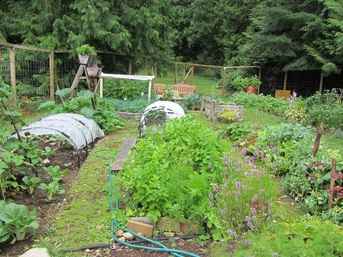Mark Nyberg, October 3, 2016
Two of the grasses that Mark used in the hanging baskets:
Silver Dragon Liliturf (Liriope spicata 'Silver Dragon')
All Gold Hakome grass (Hakonechloa macra 'All Gold')
Some of the bulbs used for the basket and planter:
Tahiti Double Narcissi
Angel Wings Dutch Iris
Green Eyes Cupped Narcissi
Christophii Allium
Two of the grasses that Mark used in the hanging baskets:
Silver Dragon Liliturf (Liriope spicata 'Silver Dragon')
All Gold Hakome grass (Hakonechloa macra 'All Gold')
Some of the bulbs used for the basket and planter:
Tahiti Double Narcissi
Angel Wings Dutch Iris
Green Eyes Cupped Narcissi
Christophii Allium
These are the names of some of the resilient plants mentioned by Sheila Watkins at our April 2016 meeting.
Grevillea-red interesting spiky flower, humming bird flower, blooms in winter, tall shrub,
Native strawberry-ground cover for under firs and cedars
Sedums
Cistus-cannot remember the species but landanifer is the hardiest and most deer resistant
Epimedium -bishops hat
Acanthus mollis-- bears breaches
Rosemary
Hebe
Iberis
Senecio
Ground covers for dry shade
Bear's breaches
Candytuft
Ajuga
Arabis
Garden Pink Pussytoes-little pink flowers (Antaria)
Grevillea-red interesting spiky flower, humming bird flower, blooms in winter, tall shrub,
Native strawberry-ground cover for under firs and cedars
Sedums
Cistus-cannot remember the species but landanifer is the hardiest and most deer resistant
Epimedium -bishops hat
Acanthus mollis-- bears breaches
Rosemary
Hebe
Iberis
Senecio
Ground covers for dry shade
Bear's breaches
Candytuft
Ajuga
Arabis
Garden Pink Pussytoes-little pink flowers (Antaria)
Hanging Basket Instructions
Best links: Fine Gardening
BBC Gardening Guide
HOW TO ROOT RHODODENDRON CUTTINGS
Cuttings should be taken on August to October mornings, from plants that are young, healthy, and well watered. Select stem tips that are of average size for the plant. Using sharp, clean secataurs, make an angled cut just below a node, to remove 6 to 8 centimeters of stem tip. Then, whittle two, very shallow, lengthwise cuts along the bottom centimeter of stem to slice away the green “bark” and expose some cambium. Next, remove all but the top 3 or 4 leaves and cut these in half if they are large. Flower buds should be removed, but not leaf buds.
Now the cuttings are ready to go into the medium:
1) Clean your pots with 1:10 bleach solution. Poke holes in the medium (50:50 peat/perlite) after it has been moistened with hot water. It should be damp but not waterlogged.
2) Dip the cutting’s bottom end into #3 rooting hormone and shake off the excess.
3) Place the cutting into the hole in the peat/perlite mix and firm the medium around the cutting with your finger.
4) Water in all the cuttings. You may spray the cuttings with “No Damp” solution, as well as the peat/perlite surface, in order to decrease the chance of fungus infection.
5) Cover the pots with plastic, provide them with bottom heat (in winter), and adequate light but not full sun. Cuttings need 100% humidity to survive.
6) If the cuttings are in sealed plastic bags, open them for 30 minutes each week. Remove any plant material that is moldy or dead.
7) After 6 to 8 weeks, inspect the cuttings to see if any have rooted. If so, gradually expose these rooted cuttings to more and more air over a week. Then transplant them into small pots, using a 50:50 peat/perlite mix with a very dilute solution of liquid fertilizer added. Keep the potted cuttings well protected over the winter in a greenhouse or indoors under fluorescent lights. Cuttings that have not rooted should be left, as described above, for as many more months as they take to root.
(From Ron Knight – May 2014)
Cuttings should be taken on August to October mornings, from plants that are young, healthy, and well watered. Select stem tips that are of average size for the plant. Using sharp, clean secataurs, make an angled cut just below a node, to remove 6 to 8 centimeters of stem tip. Then, whittle two, very shallow, lengthwise cuts along the bottom centimeter of stem to slice away the green “bark” and expose some cambium. Next, remove all but the top 3 or 4 leaves and cut these in half if they are large. Flower buds should be removed, but not leaf buds.
Now the cuttings are ready to go into the medium:
1) Clean your pots with 1:10 bleach solution. Poke holes in the medium (50:50 peat/perlite) after it has been moistened with hot water. It should be damp but not waterlogged.
2) Dip the cutting’s bottom end into #3 rooting hormone and shake off the excess.
3) Place the cutting into the hole in the peat/perlite mix and firm the medium around the cutting with your finger.
4) Water in all the cuttings. You may spray the cuttings with “No Damp” solution, as well as the peat/perlite surface, in order to decrease the chance of fungus infection.
5) Cover the pots with plastic, provide them with bottom heat (in winter), and adequate light but not full sun. Cuttings need 100% humidity to survive.
6) If the cuttings are in sealed plastic bags, open them for 30 minutes each week. Remove any plant material that is moldy or dead.
7) After 6 to 8 weeks, inspect the cuttings to see if any have rooted. If so, gradually expose these rooted cuttings to more and more air over a week. Then transplant them into small pots, using a 50:50 peat/perlite mix with a very dilute solution of liquid fertilizer added. Keep the potted cuttings well protected over the winter in a greenhouse or indoors under fluorescent lights. Cuttings that have not rooted should be left, as described above, for as many more months as they take to root.
(From Ron Knight – May 2014)


